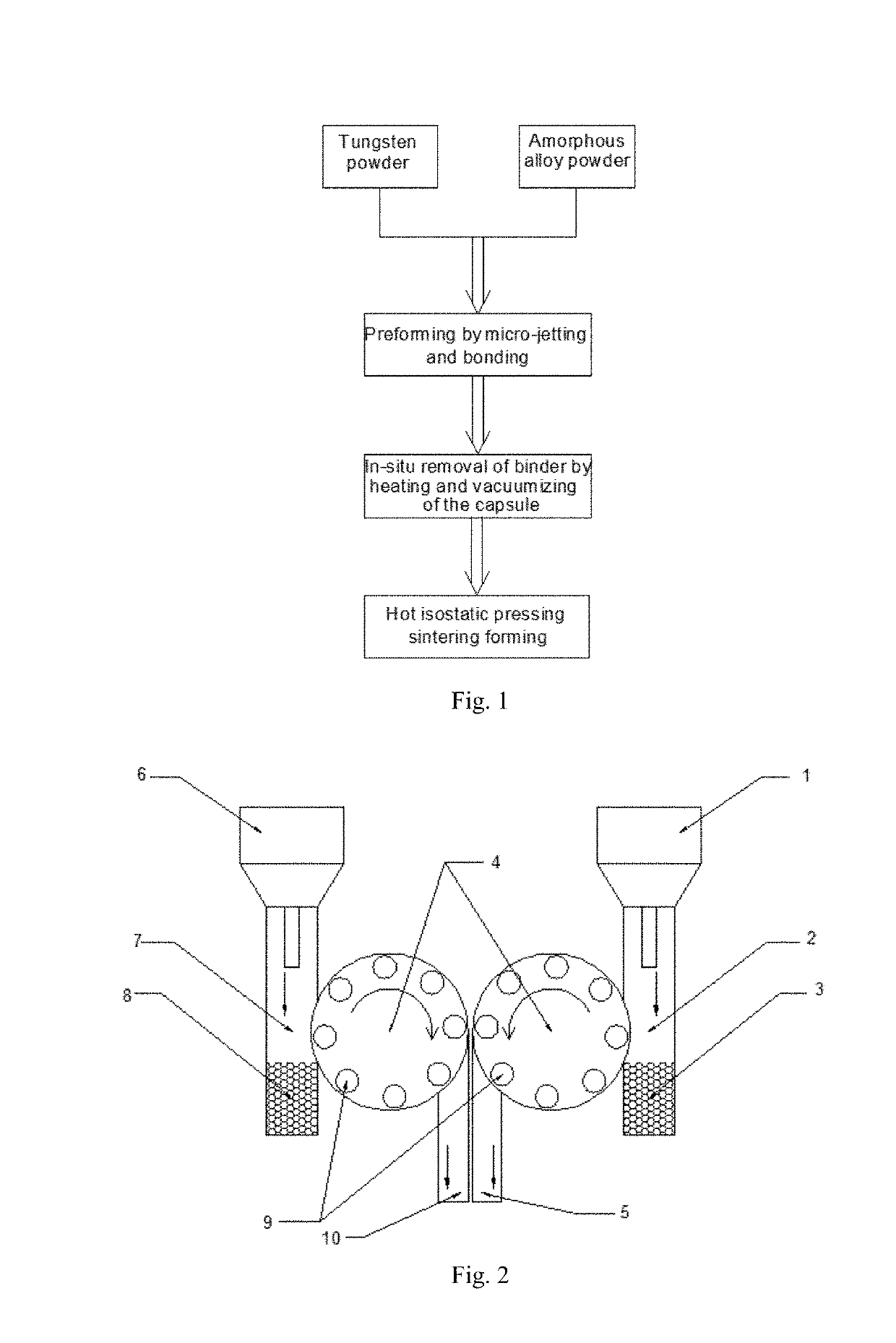Preparation method of tungsten particle reinforced amorphous matrix composites
a technology of tungsten and amorphous matrix, which is applied in the field of amorphous alloy composites, can solve the problems of limited application as structural materials, lack of macro-room-temperature plastic deformation capability, and difficulty in preparing tungsten-based tungsten-based tungsten-based tungsten-based tungsten-based tungsten-based tungsten-based tungsten-based tungsten-based tungsten-based tungsten-based
- Summary
- Abstract
- Description
- Claims
- Application Information
AI Technical Summary
Benefits of technology
Problems solved by technology
Method used
Image
Examples
embodiment 1
[0065]In the present embodiment, a tungsten reinforced Zr-based amorphous alloy composite with a volume fraction of tungsten of 20% is prepared. FIG. 1 is a flowchart of a method according preferred embodiments of the present invention. As shown in FIG. 1, a preparation method of tungsten particle reinforced amorphous matrix composites comprises the following steps:
[0066]Step (1): Preforming by the Micro-Jetting and Bonding Technology
[0067]Structural schematic diagrams of a double-drum type powder feeding device and a device for the micro-jetting and bonding technology are respectively showed in FIGS. 2-3.
[0068]The specific process is as follows:
[0069]Tungsten powder with an average particle size of 30 μm prepared by a vacuum gas atomization method and Zr55Cu30Ni5Al10 amorphous alloy powder are selected to prepare a preform. The Zr55Cu30Ni5Al10 amorphous alloy has an amorphous formation critical size of more than 20 mm, a glass transition temperature Tg of 685K, an initial crystalli...
embodiment 2
[0081]In the present embodiment, a tungsten reinforced Zr-based amorphous alloy composite with a volume fraction of tungsten of 40% is prepared. FIG. 1 is a flowchart of a method according preferred embodiments of the present invention. As shown in FIG. 1, a tungsten particle reinforced amorphous matrix composite comprises the following steps:
[0082]Step (1): Preforming by Micro-Jetting and Bonding
[0083]Structural schematic diagrams of a double-drum type powder feeding device and a device for the micro-jetting and bonding technology are respectively showed in FIGS. 2-3.
[0084]The specific process is as follows:
[0085]Tungsten powder with an average particle size of 30 μm prepared by a vacuum gas atomization method and Zr55Cu30Ni5Al10 amorphous alloy powder are selected to prepare a preform. The Zr55Cu30Ni5Al10 amorphous alloy has an amorphous formation critical size of more than 20 mm, a glass transition temperature Tg of 685K, an initial crystallization temperature Tx of 765K and a li...
embodiment 3
[0096]In the present embodiment, a tungsten reinforced Zr-based amorphous alloy composite with a volume fraction of tungsten of 50% is prepared. FIG. 1 is a flowchart of a method according preferred embodiments of the present invention. As shown in FIG. 1, a tungsten particle reinforced amorphous matrix composite comprises the following steps:
[0097]Step (1): Preforming by Micro-Jetting and Bonding
[0098]Structural schematic diagrams of a double-drum type powder feeding device and a device for the micro-jetting and bonding technology are respectively showed in FIGS. 2-3.
[0099]The specific process is as follows:
[0100]Tungsten powder with an average particle size of 30 μm prepared by a vacuum gas atomization method and Zr55Cu30Ni5Al10 amorphous alloy powder are selected to prepare a preform. The Zr55Cu30Ni5Al10 amorphous alloy has an amorphous formation critical size of more than 20 mm, a glass transition temperature Tg of 685K, an initial crystallization temperature Tx of 765K and a li...
PUM
| Property | Measurement | Unit |
|---|---|---|
| size | aaaaa | aaaaa |
| particle size | aaaaa | aaaaa |
| particle size | aaaaa | aaaaa |
Abstract
Description
Claims
Application Information
 Login to View More
Login to View More - R&D
- Intellectual Property
- Life Sciences
- Materials
- Tech Scout
- Unparalleled Data Quality
- Higher Quality Content
- 60% Fewer Hallucinations
Browse by: Latest US Patents, China's latest patents, Technical Efficacy Thesaurus, Application Domain, Technology Topic, Popular Technical Reports.
© 2025 PatSnap. All rights reserved.Legal|Privacy policy|Modern Slavery Act Transparency Statement|Sitemap|About US| Contact US: help@patsnap.com



